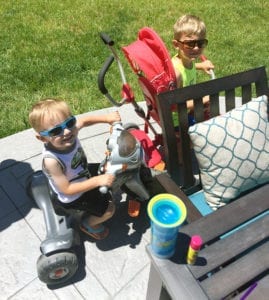My son, Quinn, was born with the most severe form of Hirschsprung disease. He has come far in his three years of age – in fact, he’s able to go eight hours without any of his three assistive nutrition modalities. This might not seem like a lot for those who are used to getting nutrition by mouth, but it’s a huge milestone for us. Here’s how the intestinal rehabilitation team – and in particular his dietitians – helped us get there.
Feeding Issues Following Birth
My pregnancy offered no clues as to what we would discover immediately following Quinn’s birth.
Our first indication that something was wrong happened when I tried to breastfeed him. He pulled away to vomit a substance that was as green as grass. Rotation of the intestines was ruled out as a cause, so he was rushed to Cincinnati Children’s for further evaluation.
Radiologic tests showed that Quinn has Hirschsprung disease, which occurs when some of the nerve cells, called ganglion, in the intestine do not form properly. When the ganglion cells are missing, food will not move through the intestines in that section. It can look different in each kid – some may only have a short segment of the intestine with missing ganglion cells – some much longer.
Quinn’s doctors then discovered during an 8 ½-hour surgery that he had the most severe form, called intestinal aganglionosis. Ganglion cells were missing in all of his colon and most of his small intestine as well. Quinn is left with 30 cm of his small intestine, jejunum only. An ostomy was also placed for the removal of stool.
Because he’s missing so much of his small intestine, he has short bowel syndrome. Problems that can result from this are malabsorption, malnutrition and dehydration.
Getting Help from Dietitians
At this point, we were overwhelmed and thinking the worst for Quinn. But a dietitian in the NICU helped ease our minds. When she said that she helps babies without stomachs get the nutrition they need, our hope was restored.
Quinn was started on TPN, or total parenteral nutrition (giving nutrients and fluids by IV that bypass the gastrointestinal tract), and lipids (fatty acids). A month after his initial surgery, he had a g-tube (tube inserted on the outside of the abdomen that connects directly to the stomach) and central line placed.
The dietitian walked us through all of his new eating modalities, and explained to us that every kid is different. Another child with the exact same diagnosis can have a completely different course of treatment. She said that we would take it day by day and see what he could tolerate, ensuring that he meets all of his nutritional needs.
He started out slowly – getting 1 ml an hour of breastmilk through his g-tube and 5 mls breastmilk three times a day in a bottle. The dietitian also encouraged me to feed him breastmilk, which I think was the key in his ability to eat by mouth later on.
Goal Setting with Our Dietitians
When Quinn first came home from the hospital, he didn’t have any time off from his continuous feedings. This meant that he was constantly attached his TPN, g-tube and central line. We longed for Quinn to have time away from his feeds – to have some semblance of normalcy.
So we made this a goal with our dietitians. In order for him to get a “window” of time free from continuous nutrition, he had to start gaining weight and maintaining blood sugar levels without it. These markers signal that his intestines are adapting by absorbing nutrients.
Around six months of age he started eating solids. This helped with his weight gain. He loves to eat and is always excited to try something new. We have to stay away from sugar so we started with meats and veggies slowly and carefully to make sure he tolerated the new foods and it did not cause too much stool. Too much stooling can lead to dehydration. Kids like Quinn can become dehydrated extremely fast, which can mean a trip to the hospital.
Quinn’s First “Window”
His very first window happened when he was four months old. He worked his way up to two hours and we felt our first taste of freedom. These windows allowed Quinn to meet all of his milestones at appropriate times. Developmentally speaking, Quinn has always been on track.
He continued to gain weight and we were slowly able to build up to a three-hour window. Then four. Then five. He continued to do so well that after one year of working with his dietitians, we’ve made it up to eight hours without him needing assistive nutrition modalities.
His current routine is:
- TPN starting at 7 pm – 11 am. (16 hours straight)
- G-tube starting at 7 pm – 7 am (12 hours straight)
- Smoflipids over 12 hours daily
A Longer Window and More Normalcy
So he’s essentially now tube-free from 11 a.m. until 7 p.m. What does this window of time mean to Quinn and our family? Everything. He gets to be a regular kid without anything attached to him for eight hours. He runs and plays tag with his brother. Rides a tricycle. And importantly, eats regular meals. We can run errands and go to the zoo and park without stares and Quinn can be independent. It’s awesome!
I’m amazed at the progress he’s been able to make and we’re so grateful for the hours of “normalcy.” Ultimately, I’d love for him to work his way up to 12 hours a day. That way he could essentially be tube-free in the daytime and only utilize assistive nutrition in the nighttime. It’s a new milestone that we’ll work towards. In the meantime, we’re making the best of the tube-free hours we have and continually hope and pray for future medical advancements.
For more information about our Intestinal Rehabilitation Program, please call 513-636-6155 or email ir@cchmc.org.






Your sons story is so similar to my daughters it was almost as if I had written it. Our daughter was also born in 2014 and was diagnosed with Pseudo Obstruction. She has ganglion cells but they are abnormal. I completely understand how long and difficult your road has been. I am so glad to hear how well your son is doing and I hope that you see continued progress. Best of luck to all of you. Thanks for sharing your story.
Awesome job!! Our granddaughter has “short gut” she had 75 %of her stomach removed to get rid of the diseases portion. Before this surgery anything that went in essentially came back up, nothing passed through. She never took a bottle as a baby and doesn’t eat solid foods. All of her nutrition comes from her formula that she gets through a g-tube. She also has a central line (after having a pic line and a port, which all ended up giving out). She came home at 10 months old to us having custody. She was on fluids, tpn and at that time j-tube feeds. All of which were pretty much continues. She is now 7 years old, in school and she only gets IV fluids ( that dehydration really does come a on FAST!) and her formula through her g-tube for 12 hours…the freedom is amazing. She still doesn’t swallow anything other then water and the occasional tiny bite of pudding for fear of throwing up, so that is all still a work in progress. We are planning our first over night trip with her to stay in a hotel in Columbus and go to the American Girl doll store….it’s baby steps for grandma and grandpa to because we don’t want to be to far away from Cincinnati Children’s but we are taking the plunge. Enjoy your new found and much earned freedom, I’m sure there is more to follow.
Great story Emily. I’m so happy to here Quinn is hitting these milestones and doing well!
This is an answer to prayer. We have a 2 month old that has the EXACT same diagnosis as Quinn. We have already reached out to the IR team via email and hope to speak with someone very soon!
Oh wow what an inspiring story, thankyou for sharing Quinn’s condition, Our grandson who is now 12 days old has just been dignosised with serve and a unique Hirschsprung Disease, baby Ase has had 2 x 9 hour surgeries in 9 days. we have been advised he only has 20% working nerves to the top of his bowel and will require PTN as his main supply of food. if be interested in learning more from Quinn’s experience and how Quinn is doing now, we have also been told that liver failure is inetable and to prepare for the worst, given Ase unique conidtion its not a common condition in Australia and Dr’s have advised he will not have quality of life and may never feed himself. Given it has only been 24 hours since we have been told, id love feed back on where i can find information and what advise you would give and if you know any one i can contract. thankyou again again for sharing
Hi Deb,
Our Colorectal Center would be happy to answer any questions you and your family have about Hirschsprung disease. Please feel free to call them at 513-636-3240, or fill out an online form for more information here: https://www.cincinnatichildrens.org/service/c/colorectal/contact
My son have hirschsprung they diagnosed him when he was a month now he is 3 month they did surgery. He is doing great now he drink 5oz formula every 3 hours but the problem is he is not pooping by him self I do ieregatien and dialation 2 a day .the doc said he will do by himself let give him a time but am worry if u have any segregation I will appreciate
Hi Mimi,
Hirschrung Disease can be challenging at times and specifically in relation to the bowel pattern that you are commenting about. We have a Colorectal Center that specializes in this disease. If you would like more information or wish to have a visit with our team, please contact call our Colorectal Center at 513-636-3240 or visit our website: https://www.cincinnatichildrens.org/service/c/colorectal/conditions-treated/hirschsprung